Andy Hertzfield, 1983 – Designing the Mac interface:
“We thought it was important for the user to be able to invoke every menu command directly from the keyboard, so we added a special key to the keyboard to invoke menu commands, just like our predecessor, Lisa. We called it the “Apple key”; when pressed in combination with another key, it selected the corresponding menu command. We displayed a little Apple logo on the right side of every menu item with a keyboard command, to associate the key with the command.”
Steve Jobs, 1983 – Upon seeing this:
“There are too many Apples on the screen! It’s ridiculous! We’re taking the Apple logo in vain! We’ve got to stop doing that!”

Rest of Story at Mac Folklore.org
Surprise, original Mac with Steve Jobs at the helm – no Apple keyboard logo:
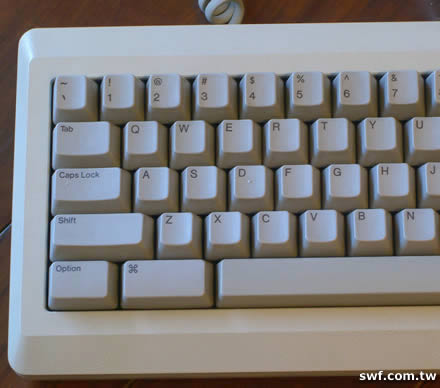
Once Steve Jobs leaves in 1986 … The Mac Plus keyboard was modified …

And of course, from 1986 to 2007 …
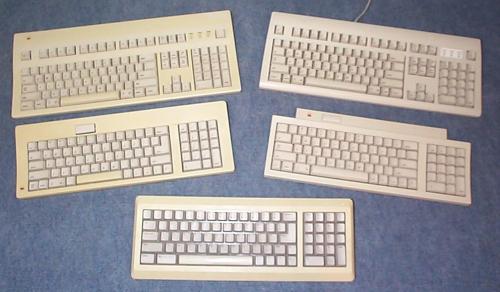

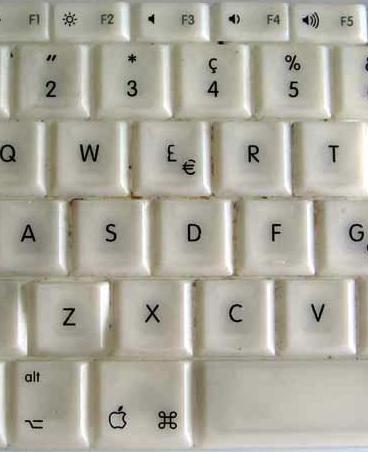
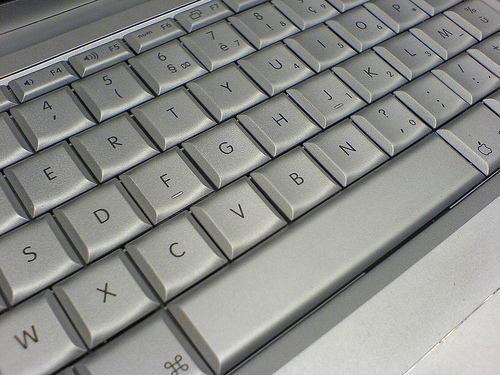
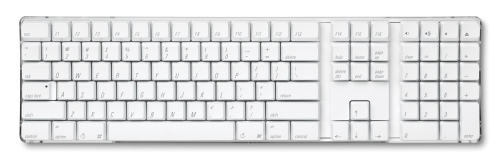
So the Apple logo on the keyboard managed to hang on for 10 years before Steve Job 2.0 remembered what Steve Jobs 0.9 said …
Apple Keyboard Logo: 1986-2007
R.I.P. along with the Apple Icon Garden …
Maybe when they bring back Retro Disneyland …

Here’s a theory. One that I feel is more probable, though yours likely has lots of validity.
Quite simply… removing the Apple from the control key makes this sexy new keyboard more appealing to a far larger audience.
A trend that has, since the introduction of iTunes for Window, has become increasingly common for Apple.
And why not sell more keyboards to Windows users, MS has been selling keyboards and mice to Mac users for years.
Just a thought.
Also, bear in mind that although Andy Hertzfield appears to have referred to a small Apple logo on the right side of every menu command with a keyboard equivalent, there is no such logo beside menu commands in Mac OS X at present. Therefore having an apple logo on the command key would serve no purpose in that context (i.e., associating the command and the key). In contrast, the remaining symbol on the command key is the one that associates the key with the menu command. It makes sense. As far as I can tell, the apple on the command key should have been removed years ago!
Pingback: University Update - Steve Jobs - Why the Apple/Command Key Finally Lost Its Apple
These iMacs are much cheaper than their predecessors. Removing the Apple logo from the keyboard was just one of many cost cutting measures.
Man, thanks for the article. I didn’t even notice the Apple key on my Powerbook keyboard until you mentioned it. And now that I look at it there’s this stupid Windows key on my keyboard at work that I never use. Maybe that’s why the Apple was eliminated? After a while, you start identifying it as the key on the keyboard you never use, and that can’t be good psychologically.
the windows key serves a purpose. it opens the start menu. The Apple Key should’ve had that purpose, its purpose was to open the Apple icon on the top left side of an app.
Pingback: Um minuto de silêncio em memória da tecla Apple | AppleMania.info
Pingback: Um minuto de silêncio em memória da tecla Apple | AppleMania.info
Pingback: Top Posts « WordPress.com
In response to G-moon: The Apple key served a much more useful purpose than just opening the Apple menu. It allowed one to perform many useful contextual commands, rather than just one static one. In a way, I’m sad that the Apple is gone. It really did serve a purpose (whether intended or not); and that was to direct one’s attention to it. Since it is an Apple computer, the Apple key would, logically, be the most important key. For a novice searching for the right key combination, the Apple would stand out above the rest.
And another reason to keep the apple: It is a whole lot easier to tell someone to press Apple-Q than Command-Q, and easier to type.
Finally, it differentiates itself from Windows and Linux by not using the Control key. Now, when someone goes to press a key, they will have to decide between control (take control, that sounds like what I need), option (nah, that’ll just give me more options), and some funny looking blob. Oh, well.
I bet there will be many many aftermarket stickers now to replace the kidnapped Apple. If so, I want one!
There are plenty of folks with memories of the old Apple II days who still refer to the command key as the “Open Apple Key.” In the Apple II line, there was an “Open Apple” and a “Solid Apple” (or “closed Apple” as some called it) key. The Solid Apple key later became the Option key. The cloverleaf, by the way, came from a Swedish road sign that generally meant, “a remarkable feature.”
Simple Beep,
It does not “differentiates itself from Windows and Linux by not using the Control key”. The “Apple Key” existed even on the Apple II. The PC keyboard did not get a “Windows Key” until 1996, so when MS copied the Apple Key-combination concept, they had to use one of the existing modifier keys designed for operating systems that pre-dated DOS.
(Macs copied the F1 – F10 keys from IBM)
Linux GUIs copy Windows in every way they legally can, including the “corner key instead of key next to the spacebar” that MS pioneered to make their copy different enough to satisfy the lawyers.
The modern Windows interface was introduced 11 years after the Mac, yet people still call the Mac “upside down and backwards” and Windows “normal”, even though the metaphor originated at Apple.
(The windowing GUI at Xerox did not have overlapping windows, a menubar, or the “desktop” metaphor of files/folders/trashcans. Those all came later @ Apple)
MS gave us Alt-Tab and the Help Menu… invaluable innovations they never get credit for because of how much they copied from Apple’s post-Xerox GUI development.
I love my open apple key. . .
RIP closed apple key. . . .
God, my wife looks at me funny whenever I say ‘open apple’ about that key on her Powerbook … she just doesn’t remember the good old days of Logo II and Oregon Trail … and the difference between the open and closed apples … heh
I think they left out the Apple key because the Mac has become a truly cross-platform machine since moving to Intel chips. People are running Windows and Linux on Macs now. Removing the Apple key just makes that migration a little bit easier.
It may seem insignificant (it’s just a small key, right?), but it does away with a tremendous psychological barrier that makes using the new machine more confusing than it should be. I had the same problem when I first started using the Mac 5 years ago, not being used to seeing an Apple key on my keyboard before.
Just to prove my point: on 2 of my Macs I use compact laptop-style keyboards designed for Windows, and which still have the Windows key on them. A freelance designer who’s used to only Macs found this terribly confusing — he just couldn’t execute shortcuts in Quark Xpress. And it’s just a simple change in the key.
Pingback: We hardly knew you. at A Bird’s Life
T.D.,
the Xerox PARC interface *did* have overlapping windows. They did not, however, have a method for directly manipulating (dragging) their positions with the mouse. And to clarify, they did have menus…it was a different implementation; not a static menu bar location and they didn’t represent actions/commands as they do in the metaphor Apple invented. I wonder about the Help menu. I remember it in System 7.
and Jessecuster…Viva la turtle!
to me, the command key is the most important key on my keyboard. I use it thousands of times per day as keyboard shortcut commands in the adobe creative suite (and subsequently cmd+w or q for closing programs or windows faster). the apple being removed doesn’t bother me, only removing the whole key in general would. having the command key closer to the space bar makes it easier for me to use my thumb plus index finger to hit every key on the board – and what’s even better? the second one on the other side of the keyboard.
if i ever have to go back windows (god save my sorry soul) i would dread having to stretch that extra 3 inches for all my key commands. (and where would i be without cmd+opt+ctrl+y for overprint view in InDesign)
One reason I think they got ride of the Apple symbol is because the “command” key had two symbols–the Swedish symbol for tourist spot which looks like a clover and is actually supposed to represent a fort; and the open Apple symbol. Now, why would a key need two different symbols? So, get rid of one of them!
I don’t know why, but for some reason the loss of the apple makes me feel sad. 😦
Oh well, at least my laptop has apples on the keys! ^_^
Here in Europe a lot of apple-user (maybe nearly all) are using the term “apple-o(pen)” and similar. we dont use “command”.
i guess that switcher (if they are not blind) would easily find the “apple” on the keyboard.
its a shame that this key is removed and maybe its a big mistake (like a mercedes without a “mercedes-stern”)…
IF APPLE-COMPUTERS BECOME INTERCHANGEABLE, EXPECTED WINDOWS-USERS COULD ASK WHY THEY SHOULD SWITCH!
loyal apple-users in europe are used far more not to be important for apple!! we are used to that for more then 10 years…
About time the word “command” was added to the command key.
I just think the Apple key… excuse me, the command key was suffering from a multiple personality disorder. Just like the alt key… excuse me the option key.
Not long before Steve Jobs’ second coming to Apple in 1996 he was giving a talk to The Stanford Graduate School of Business’ High Tech Club at the home of a student. For three hours he sat in the lotus position on the floor in front of the living-room fireplace answering questions good-naturedly. Afterwards, the host, a young MBA candidate named Steve Jurvetson, asked the legendary figure to autograph his Macintosh keyboard which had already been signed by Apple cofounder Steve Woznyak.
Steve Jobs said he’d do it, but only if first he could remove all the unnecessary keys that his successors had added in a foolish effort to make the Mac more like a Microsoft-Intel PC. He despised the long row of so-called function keys (like “F1”) and the cluster of navigational arrow keys which were clunky alternatives to the more intuitive process of using a mouse to explore menus and icons. So Jobs pulled his car keys out of his pocket and began scooping into the computer keyboard, violently disgorging all the keys that offended him. “I’m changing the world one keyboard at a time”, he said with a straight face. Only then when he had mutilated the apparatus, did he take a pen and scribble his autograph on it. He was making a statement: he still had an intensely proprietary feeling about Apple’s computers and he yearned to restore the company in accordance to his vision.
Alan Deutschman, The Second Coming of Steve Jobs, 2001
Of course, the Apple key began life on the Apple ][ keyboard!
Put it back, put it back, put it back. I too feel sad, the apple key gave it character and made it unique.
Can Windows users drop the Microsoft key now then too?
I’m all for dropping the microsoft key… on it’s head. This makes me wish I had my apple II again.
A lot of stupid things in terms of branding have come from Cupertino recently.
Millions of tutorials and CBTs will become useless, millions of brains will have to be re-wired since “Apple-something” is the appropriate way to describe a command.
All because some of the designer folks who have taken over completely and leave the rest to Intel (and soon Microsoft) said: ‘hey, that command key looks childish and cluttered with TWO emblems on it. “command” looks way more professional. ‘
They’d better put a decent graphics card in the new iMacs instead of crippling the keyboard…
Here’s something interesting.
1. The Apple key was first used on the Apple ///, Steve Jobs’ first big failure at Apple. Then, he was kicked out of the Apple //e project which re-used the Apple key and then, out of the Lisa project which also used the Apple key. In fact, by contrast, the Lisa had Apples all over its menus. Then Jobs set the Macintosh team against the rest of Apple. So it’s no surprise he wanted to distance himself from the Apple key and related implementation.
2. Since the introduction of the Apple key on the Apple ///, every stand-alone Apple keyboard has had the Apple/Command key until 2007 (including the Newton keyboard). Except two: the original Macintosh keyboard and the Macintosh Plus keyboard, which instead used the propeller icon. Of those, only the Plus keyboard did not include an Apple logo on the face of the keyboard (there wasn’t room). Every other keyboard Apple built included a logo as well as the Apple key until 2007. Like the Mac Plus keyboard, the new Aluminum keyboards have no Apple logos on their face AND they dropped the Apple from the Command key, essentially dropping any identifiable marks branding the new keyboard as manufactured by Apple. Only the propeller icon ties it to the Mac and that’s a generic icon. So in a very real sense, the Apple icon on the Command key helps brand Apple’s current line of peripheral keyboards. That alone is reason enough to keep it. As far as branding logos goes, all other Apple products have always had a visible logo on them, except their current line of keyboards … oh and the Mac Plus keyboard.
3. And Steve Jobs still needing to distance himself from the Apple key after 28 years … priceless!